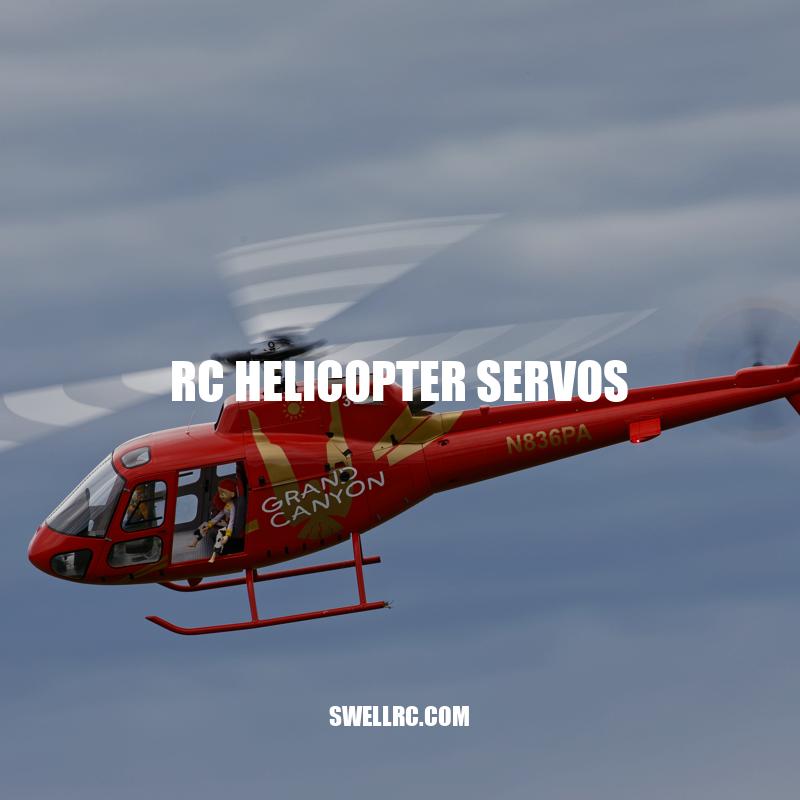RC Helicopter Servos: Importance, Types, Selection, Maintenance, and Troubleshooting
RC helicopters are fascinating to fly for fun or to take part in competitions. While these miniaturized machines are comparatively fragile, the helicopter’s stability and responsiveness depend on its servos. As an RC helicopter enthusiast, it is important to understand how servos guide and translate copter commands into actual movement. Servos are electromechanical mechanisms that make quick movements, which can turn a helicopter to the left or right, fly forward or back, rise or descend. Servos provide a crucial role in the proper functioning of RC helicopters, and the right choice of servos can significantly impact the stability, flight, and precision of these flying machines. Therefore, selecting the best type of servo for an RC helicopter, cleaning, lubricating, and maintaining them can substantially contribute to better performance and longer life. In this article, we will discuss everything you need to know about RC helicopter servos, including types, selection criteria, maintenance, and troubleshooting tips that would help you make the most out of your RC copter and minimize the risk of damages or crashes.
Types of RC helicopter servos
There are various types of RC helicopter servos available in the market. Here are some common types of RC helicopter servos that you need to consider when buying one.
- Analog servos
- Less expensive than digital servos
- Provide relatively low precision movements
- Suitable for beginner RC helicopter pilots
- Digital servos
- Provide refined precision movements compared to analog servos
- More expensive than analog servos
- Response speed is faster than analog servos
- Suitable for experienced RC helicopter pilots
- High-torque servos
- Used for bigger and heavier RC helicopters
- Produce high force output or strength
- Low-torque servos
- Used for lower weight and smaller RC helicopters
- Produce lower force output or strength
- Standard servos
- Medium size servos suited for most RC helicopter models
- Provide precise movements, speed, and torque output
- Micro servos
- Smaller servos for compact RC helicopters.
- Easily fit small servo pockets
- Suitable for lightweight or tiny RC helicopter models
It’s essential to choose the right type of RC helicopter servo that will match the model’s weight and power requirements. You also need to consider the cost, the brand’s quality, and the available features before buying one. You may visit some websites such as Amazon, Horizon Hobby, or HobbyKing for a list of available servos that you can buy, and read customer reviews before making your decision.
What are the different types of RC servos?
There are three main types of RC servos available:
| Type | Description |
|---|---|
| Analog | The most common type. Provides a simple interface for controlling movement and direction. |
| Digital | A more advanced option that provides faster response times and better accuracy. Can also be programmed for custom movement patterns. |
| Brushless | The most advanced option. Provides faster response times and greater durability. Typically more expensive than the other two types. |
There are many websites and products available for RC servos, including popular retailers such as Amazon and HobbyKing. It’s important to research and compare options to ensure you choose the best option for your specific needs.
When selecting the best RC helicopter servo, there are several factors you need to consider. Here are some of the most important things you should consider to help you make an informed decision:
- Size of the helicopter and the servo
- Weight of the helicopter and the servo
- Speed, torque and precision movements offered by the servo
- The level of experience of the RC helicopter pilot
- Brand preference
- Budget
- Compatibility of the servo with your RC helicopter’s radio system
To help you choose the right RC helicopter servo, here is an example table that lists some common RC helicopters and the compatible servos that suit them:
| RC Helicopter Model | Compatible Servo |
|---|---|
| Blade 230S V2 | Futaba S3150 Digitial Micro Servo |
| Align T-Rex 550E/600E | Savox SW-2270SG Monster Torque servo |
| SAB Goblin 500/600/700 | Hitec HS-5065MG Digital Micro Servo |
| Blade Nano S2/Nano CP S | Spektrum H3050 Sub-Micro Digital Servo |
You should also consider checking some websites such as Amazon, and HobbyKing for their comprehensive list of RC helicopter servos, including their specifications and price. Some of the most known servo brands include Futaba, Hitec, and Savox. Additionally, some mid-range digital servos offer a good balance between precision and price, making them suitable for most pilots.
How do I choose an RC servo?
When choosing an RC servo, there are a few key factors to consider. These include:
- Torque: the amount of force the servo can exert to move an object.
- Speed: how quickly the servo can move an object.
- Size: the physical dimensions of the servo, which can impact compatibility with your RC vehicle or project.
- Price: the cost of the servo, which can vary widely depending on its features and quality.
To choose the right RC servo for your needs, it’s important to consider the specific requirements of your project and match those with the capabilities of different servos on the market. Researching online and reading reviews from other RC enthusiasts can help you narrow down your options and find a high-quality servo that will meet your needs.
Some websites that offer a wide selection of RC servos include:
| Website | Pros | Cons |
|---|---|---|
| HorizonHobby.com | Wide selection of brands and servos, including options for different vehicle types (e.g. cars, planes, boats). | Prices tend to be on the higher end compared to some other websites. |
| TowerHobbies.com | Large inventory of servos at varying price points. | Website can be overwhelming to navigate for beginners. |
| Amazon.com | Offers a wide range of brands and models, often at lower prices than other websites. | Quality can occasionally be inconsistent, and it can be difficult to know which sellers to trust. |
Overall, taking the time to research and compare different RC servo options is key to finding the right product for your project.
Maintaining and troubleshooting RC helicopter servos
To keep your RC helicopter servos in top condition, you need to maintain them properly. Here are some essential tips for maintaining and troubleshooting your servos:
- Regular cleaning and lubrication of the gears and other moving parts of the servo to reduce friction and wear.
- Inspect the servo for any physical damage, corrosion and loose or broken parts before each flight to prevent accidents.
- If you notice any unusual noise, resistance or lack of response from your servos, investigate the problem to prevent a potential crash.
- Loose or cut wires can also cause your servo to malfunction, so make sure to check the wiring regularly.
- Replace any broken, damaged or worn-out gears immediately to keep your servo functioning at its best.
- If you are unsure about any issues with your servo, consult a professional to avoid making the problem worse.
Some common issues that RC helicopter enthusiasts may face with their servos, and how to address them include:
- Striped gears: A sign of this problem is your servo spinning without moving. You can fix this problem by replacing the worn-out gears.
- Broken wires: Inspect the wiring in your servo if it’s not working correctly. Use soldering iron to fix the loose or broken wire.
- Faulty potentiometer: If your servo is vibrating or responding erratically in use, you may have to replace the potentiometer.
By following these tips, you can avoid most problems with your servos and enjoy peak performance from your RC helicopter. If you are looking for high-quality RC helicopter servos, some top brands include Futaba, Hitec, and Savox. Online stores like Amazon and HobbyKing are great places to shop around for new servos that fit your budget and preference.
What are the controls of RC helicopter?
RC helicopter controls vary depending on the specific model and type of helicopter. However, most remote control helicopters feature at least four basic controls:
- Throttle: This controls the altitude of the helicopter. Pushing the throttle up will make the helicopter lift off, while pulling it down will bring it back down to the ground.
- Aileron: This control allows the helicopter to move left and right. Moving the aileron stick left will cause the helicopter to tilt left, while moving it right will tilt it to the right.
- Elevator: The elevator control moves the helicopter forward and backward. Pushing the elevator stick forward will make the helicopter move forward, while pulling it back will cause it to move backward.
- Rudder: The rudder control allows the helicopter to spin around its vertical axis. Moving the rudder stick left will cause the helicopter to turn left, while moving it right will turn it right.
Some advanced RC helicopters may also include additional controls for features such as stabilizers, camera gimbals, and LED lights.
For more information on RC helicopter controls, check out websites such as rcgroups.com, rcuniverse.com, or heliguy.com which offer a variety of resources and product reviews to help you choose the best remote control helicopter for your needs.
Conclusion
RC helicopter servos are a critical component in controlling these miniature flying machines. Choosing the right servo and maintaining it correctly can make all the difference in the performance of the helicopter, while improper handling can lead to disaster. Remembering these essential tips can help you choose the right servo for your helicopter, keep it working correctly, and be an efficient troubleshooter in case any issues arise. The success of any RC helicopter enthusiast depends on their knowledge of their helicopter’s equipment, and the servo is undoubtedly one of the most important pieces of hardware to understand. Always keep your helicopter and its parts in top condition for safe and enjoyable flying experiences.



